Landing Page
Special Projects
This story is part of a series of specially designed stories that represents some of the best journalism The Post has to offer. Check out the rest of the special projects here.


Maddie Meyer
10/18/2018
On Sept. 1, 2012, Ohio and Penn State met at Beaver Stadium in Happy Valley.
The first game of the season for both teams, the Nittany Lions were reeling from the scandal involving legendary coach Joe Paterno and his handling of former assistant coach Jerry Sandusky, who was revealed to have sexually abused boys for years. Bill O’Brien, previously the New England Patriots’ offensive coordinator, was hired to replace Paterno.
In July 2012, the NCAA imposed several sanctions on Penn State. The Nittany Lions were allowed to continue as a program, but players on the roster were permitted to transfer to other schools without the standard penalty of one year of ineligibility. That resulted in at least nine players transferring from Penn State, including starting running back Silas Redd.
Still, the Nittany Lions expected to win, hoping a win would begin the healing process within the university. The core group of players was still intact, and the fan base had an “us against the world” mentality.
Ohio thought differently. Coming off its 2011 campaign — which saw the team win its first bowl game in program history — Ohio was feisty and filled with veterans. Coach Frank Solich was entering his eighth season in Athens. With quarterback Tyler Tettleton at the helm of the Bobcats’ offense, Solich had one of his most dynamic teams.
The Bobcats went on to beat the Nittany Lions 24-14 that afternoon. It was a program-shifting win. The Post spoke to coaches, players and media members who played in or were at the game.
Before the game

Alex Goodlett
Ohio head coach Frank Solich
Ohio players and coaches witnessed the turmoil in Happy Valley that summer, knowing they had Penn State on the calendar. The Bobcats were aware that the two teams’ meeting would be the Nittany Lions’ first game since Paterno’s firing and death and the NCAA’s sanctions. The country’s eyes were on Penn State, not Ohio. The game, which kicked off at noon, was televised on ESPN.
Ohio running back Beau Blankenship: “(The hotel) was a piece of crap. I remember it vividly. I was rooming with Tyler (Tettleton), and, sitting in the hotel, it was literally a dump. We had our meetings that morning. We watched a hype video before we played, and this one was about the opportunity we had for this game and how we needed to play.”
Ohio quarterback Tyler Tettleton: “Once it became game week, shoot, we knew we were going to go into an emotional environment. Those are the games you circle on the calendar. There’s a little more of a chip on your shoulder when you’re going against those kinds of teams.
“We drove there. I’d never been to West Virginia or Pennsylvania, which was the route we took. I was looking forward to the drive, just seeing how everything was. On top of that, just driving into Happy Valley was pretty unique, kind of intimidating.”
Ohio radio play-by-play announcer Russ Eisenstein: “So, from an outside standpoint — as in not on the team, not on the coaching staff — and analyzing the game a little bit more, throwing in all things that surrounded it, that really made me think, ‘Gosh, this is gonna be a tough one for Penn State to play.’ And rightfully so. They had to deal with so much. How are they going to perform? How are they going to play? So, from a purely football standpoint, and then knowing the emotions that 18- to 22-year-olds (have), and then add all of this stuff on there, too? It was tough for Penn State, and, oh, by the way, they're playing a pretty good Ohio team.
Penn State radio play-by-play announcer Steve Jones: “You can’t really describe what the Penn State players had been through unless you’re actually standing in the shoes of the Penn State players.”
Ohio defensive back T.J. Carrie, who didn’t play due to injury: “They had so many distractions going on that it gave us a greater chance going in there. It gave us a lot more confidence going in there to play a team like that, and we felt great with our matchups.”
Ohio coach Frank Solich: “We wanted to stay away from that (scandal) and just play football. Obviously, whatever Penn State team showed up, that's who we were going to play.”
Ohio tight end Jordan Thompson: “Everybody across the country was going to be watching that football game.”
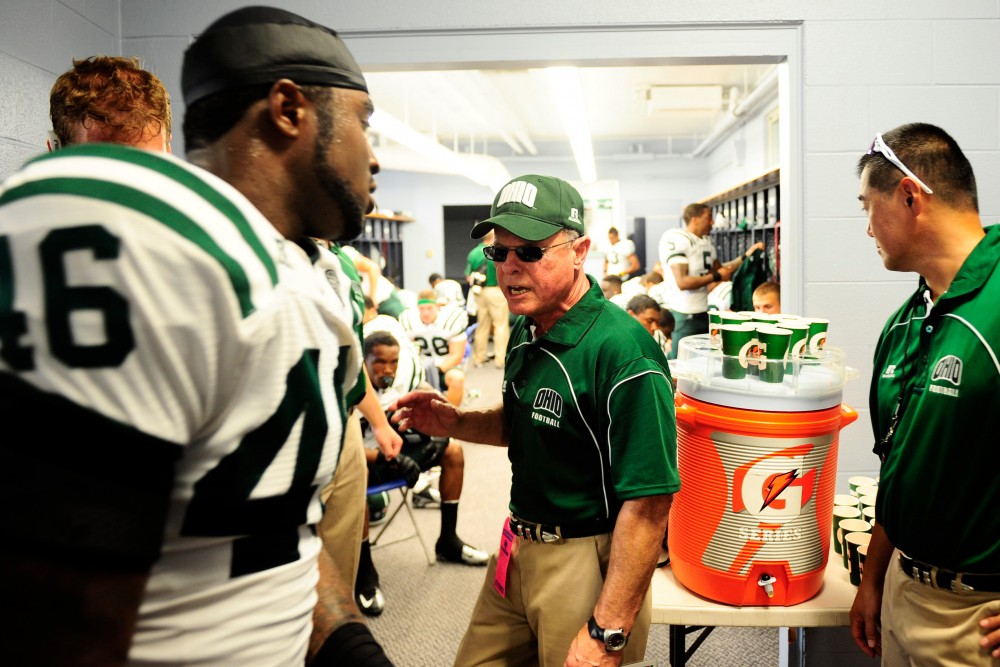
Alex Goodlett
Ohio head coach Frank Solich.
Before the game, Solich told his team to imagine the reactions on Court Street if the Bobcats were to win. On ESPN, analyst Lou Holtz said, “It’s Penn State, and Penn State knows how to win.”
The Bobcats started the game off slower than they had hoped. Penn State drove down the field on the opening possession of the game but fumbled the ball. From there, the Nittany Lions scored two touchdowns in the first half, starting with a Matt McGloin 6-yard touchdown pass to running back Bill Belton. Ohio was able get on the board when Matt Weller hit a 22-yard field goal. As the half wound down, McGloin threw his second touchdown pass, this time a 14-yard pass to tight end Matt Lehman. At halftime, it was 14-3 Penn State.
Solich: “I don't think the mood dropped off because we were behind at halftime. I think (the players) remained confident and energetic, and they wanted to go out and play with a lot of energy in the second half. They felt they could work their way back into it.”
Ohio wide receivers coach Dwayne Dixon: “I just remember our guys didn't have any fear about what was transpiring. They didn't get down. ... We've always trained like that, where coaches say, ‘Don't get too high, don't get too down. Just play the game one play at a time, and do your best during those plays, and let the chips fall where they may.’ That's the attitude that I think Coach tried to use in that situation in terms of things he's done in the past here.”
Eisenstein: “I do think that Ohio could have played better in half one. I think that they think that way, too. There were a couple of plays that Penn State scored on in which you saw that they were Big Ten athletes. And not to say that Ohio didn't have players to back up with them, but they made a couple of Big Ten-like plays: a couple of broken tackles, a couple of tough plays to keep drives going. But you still had a thought that it was a manageable deficit if Ohio could just find the end zone, and eventually they did. But at halftime, it wasn't like, ‘Gosh, Ohio can't come back and win this game.’”
Jones: “I thought (the Nittany Lions) were playing well and were probably on their way to winning the game probably by a couple touchdowns — maybe 17 points — because I thought, (in) the first 30 minutes, that’s how well they played. But then Ohio came out in the third quarter, and they really changed the tone of the game. And when they changed the tone of the game, they did it in such a way where you looked back and say, ‘Uh-oh, (Penn State’s) in big trouble here because suddenly a good football team believes in themselves.’ The longer you let a good football team hang around and the longer you let them believe in themselves, the more dangerous it becomes for the alleged favorite.”
Blankenship: “Just going into (the) half, we’re in it. We didn’t have much running room in the first half. I think we were wearing them down.”
Tettleton: “I remember we knew we could hang with these guys. I remember that we had left a lot of plays out there. We knew we could move the ball on them. We needed to be ourselves. I think in the second half we did that. We controlled the line of scrimmage, do a lot of things on offense, move the ball and defense stepped up, too. We went out there and put together a pretty special second half.”
Ohio wide receiver Donte Foster: “I just remember how much bigger they were than the normal (Mid-American Conference) schools. That’s the biggest thing I remember going into halftime. They’re big and they’re fast, so what can we do offensively to turn this around? My mindset was, now that I got these pregame jitters out, I know I can play with these guys. You only have one opportunity to beat this team — you’re never going to see them again. If you’re going to turn it on, you’re going to have to turn it on now.
“Looking across at Tyler, he was frustrated because, obviously, he was the leader of the group and he knew that we could be playing better than we were. We talked about some offensive schemes that we thought would work. Tyler sat there and said (the Nittany Lions) weren’t that good — we can play with these guys.”
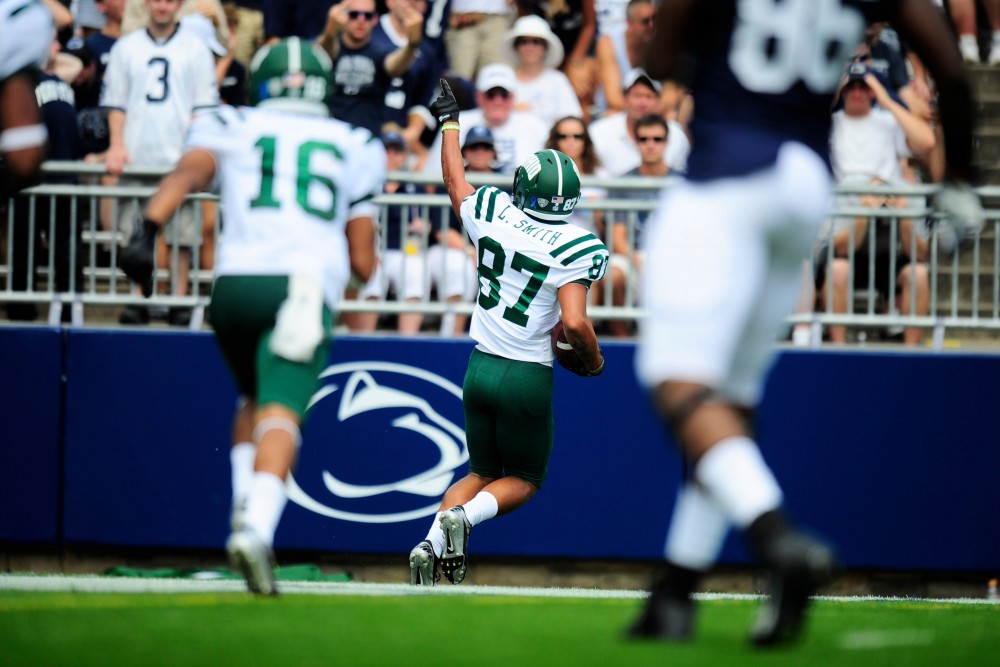
Alex Goodlett
Ohio wide receiver #87 Landon Smith.
After the slow start to the game, Ohio knew it was still in it but needed to score early in the second half. The Bobcats received the ball to start the half and promptly went on a 12-play, 82-yard drive that was capped off by a 43-yard touchdown pass from Tettleton to wide receiver Landon Smith. The ball was tipped and nearly intercepted by a Penn State defender. Instead, it fell into Smith’s arms, and he sprinted into the end zone.
Ohio was down 14-10 with 10:40 to play in the third quarter.
Jones: “I thought, going into the game, that Ohio was really good because I thought Tettleton was outstanding at quarterback. I just liked the way he handled himself. He ran when he had to run, and he had a really good arm. Anytime you have a guy like that, any team becomes a problem.”
Blankenship: “I remember it perfectly. I remember (Tettleton) throwing it. I think we were in double coverage. It was tipped, and (Smith) caught it off the tip and took it. That deep ball was probably play-action, then protecting Tyler.”
Dixon: “Yeah, we thought it was going to be a turnover, but Landon comes out with it. It was just an awesome feeling, seeing one of the guys that you coach actually not get distracted. We call that a ‘distraction drill,’ and I’m sure we work on those things during that week. (The drill) changes direction, and sometimes we put people in front or we have guys just try to mirror a guy and throw it past them so they (have) got to catch the ball with somebody around them. We do those drills a lot.”
Eisenstein: “As I mentioned, if Ohio could just get into the end zone, that would allow everyone that wanted Ohio to win the game and everybody playing the game for Ohio and coaching the game and around the game for Ohio, that touchdown allowed them to say, ‘All right, here we go.’ And the play itself was moving from right to left from our vantage point. It was basically right below us, and it was on the end zone on the side of the field that we were on. I remember in the past thinking, ‘Gosh, I hope it's going to get there.’ Because there were a couple of hands in the way, there were a couple of bodies in the way, but Tettleton was able to get it in there. I don't remember if it was flipped or not — I’d have to look back at it. I thought, ‘All right, big play for the Bobcats. Here they are at Penn State, and they’re really in this game now.’”
Thompson: “There’s times when great things happen, and there’s also times when there’s a lot of luck on your side. It’s all meant to be. That was the boost that got us going.”
Tettleton: “It was crazy. It was a broken play. I drop back, and I remember vividly I had some pressure up the middle. Had to escape a little bit, and I saw (Smith) just screaming up the middle and wide open. I threw it off my back foot, under duress. Lobbed it off. The safety from the backside had a chance to come up and undercut it, and (the ball) totally went right through his — probably would’ve been the easiest pick of his life — hands and into Landon’s arms, and then he did the rest. It was unbelievable.
“Probably a game-changing moment. If they had gotten the ball there, shoot, they could’ve just easily flipped the momentum. Totally different ball game.”
Carrie: “The atmosphere — it was lights out, man. We made a lot of good plays, a lot of great memories from that game as far as plays made by teammates. You know, me jumping up on the sidelines, coaching players on the sideline, just giving them as much confidence as I could from that standpoint. But we had fun.”
Jones: “There was a sense in the broadcast booth (that the momentum had swung).”
Foster: “The ball got tipped up really high, and Landon came down with it. I’m running down the field with Landon, trying to block for him. He was going to score regardless, but I wanted to get a good block in to let him know, we’re here to. I think Tettleton tried to throw it to me. That’s the only reason why I was right there next to Landon. It was across the middle of the field, either a post or dig route.”
Solich: “I want to see more plays like that.” *laughs* “Do I remember the play? Yeah, I remember the play.”
Penn State’s next possession was an 11-play drive, but it only traveled 49 yards. The Bobcats forced a 4th and 5, but the Nittany Lions turned the ball over on downs when McGloin’s fourth-down pass fell incomplete. Thanks to their defense, the Bobcats officially had momentum on the road.
Ohio defensive coordinator Jimmy Burrow: “I remember (O’Brien) saying in a video we couldn’t tackle. We went in there confident. I think the guys fed off the crowd; the defense played really well. We had some key stops at the end. There was a big third-down stop at the end to seal the deal.”
Eisenstein: “There was some toughness there. There were big plays that were there to be made, and they made them. It was a tough and gritty defensive effort against a Big Ten team. They didn't allow some of the things that allowed (Penn State) to have success in the first half to happen in the second half. And once the offense really started to get going, I think the defense really followed suit to combine into something really cool.”
Ohio offensive coordinator Tim Albin: “Our defense played well enough to keep the score somewhat low so we didn’t get into a shootout.”
Blankenship: “(The defense) just stepped up. They played awesome. There were some big time players.”
Ohio defensive tackle Tremayne Scott, now the team’s defensive line coach: “I believe we had a really good defense. We had a lot of leadership. We had a developed group. There was a few plays I made in the backfield that I still think about.”
Jones: “(Ohio) can’t come back and win unless they shut Penn State down, and they made great adjustments and ... they opened the door for the offense to just keep scoring and win the game. … The defense was the reason they walked out of there with a win.”
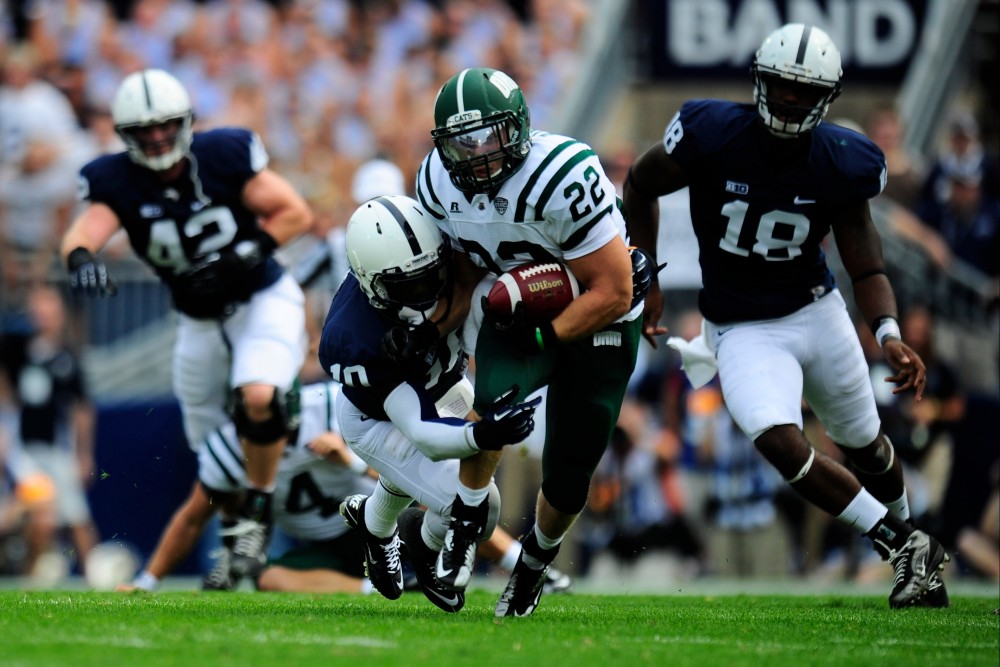
Alex Goodlett
Ohio running back #22 Beau Blankenship.
Ohio’s offense took advantage of its defense’s success. Taking over after the turnover on downs, the Bobcats marched 70 yards on eight plays. Blankenship accounted for 23 yards, and Tettleton punched in a 1-yard touchdown, giving the Bobcats the lead with 3:49 left in the third quarter. They didn’t give it up.
Tettleton: “Just excited to take the lead.”
Blankenship: “We were driving. I was physically shot. I was tired. I didn’t care who scored. I just wanted to get in and get the points.”
Eisenstein: “Just his body type, his makeup, his work ethic, (Blankenship) belonged in the uniform and playing in that sort of game. So there are a lot of similarities between he and (current Ohio running back) A.J. (Ouellette). Just in how they run, how persistent they are, how tough they are, how coachable they are. So there are a lot of similarities between Beau and A.J., and you saw that with Beau, and now we see that with A.J.”
Solich: “The vibe of the team? I think our team winning the game, thinking they were going to win, that remained throughout the game, even when we got behind.”
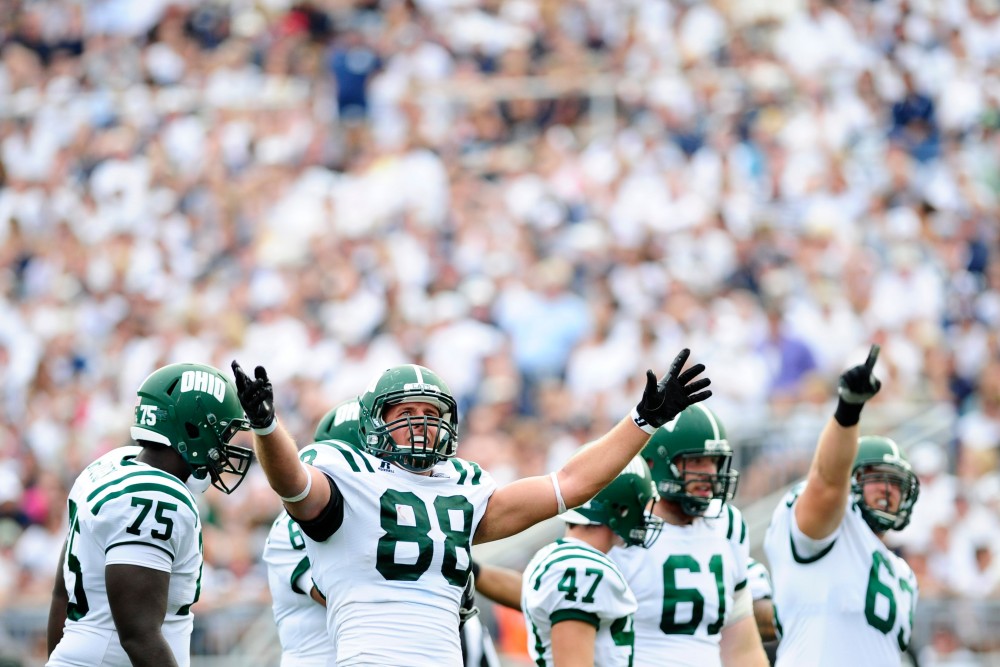
Maddie Meyer
Ohio tight end #88 Jordan Thompson.
Ohio had Penn State on the ropes and needing to answer. But the Nittany Lions punted on back-to-back possessions, opening the door for Ohio to seal the game. Ohio started its penultimate drive on its own 7-yard line. From there, the Bobcats traveled 93 yards on 14 plays and ran nearly seven minutes off the clock. They converted three third downs. The final play of the drive — on third down for the fourth time — was a touchdown pass from Tettleton to Foster. It was a dagger.
Tettleton: “I just know we kept chipping away, getting first downs. Just being in huddle saying, ‘This is our moment. This is what we came here for. Let’s go finish this thing off.’ I remember looking every guy in the eye. It was just a different feel at the beginning of that series.”
Jones: “The (Penn State) players are trying hard to show everybody that everything’s going to be OK. Sometimes, you lose control of a situation. It was one of those games where Penn State lost control of the situation. And when you go on a 14-play, 93-yard drive, it shows you which team is in control.
“(The Penn State players) put so much pressure on themselves that finally when Ohio took control of the game, they weren’t ready to know how to respond.”
Eisenstein: “I called it in the lead-up to the actual play-by-play of the play that you thought that if Ohio could get in to the end zone, this game was done. It was the patented Ohio fade that so many quarterbacks and so many wide receivers have run at Ohio, to Donte Foster. And you thought, if they could get in here, this game could be done. They got in there, and I called it as, ‘Well, that could do it.’ And it really did.
“That was a classic Ohio drive. There have been a lot of Ohio drives. There was a drive at Bowling Green, if I remember, to win a division title in which Ohio just kind of marched the field. We've seen it in big games, we've seen it in supposedly not big games, but we've seen some drives to be able to win games, and that was one that put it away.”
Albin: “They went zero blitz. We got a corner route out of Donte Foster, and (Tettleton) drops a perfect pass into the end zone.”
Thompson: “We were going into their student section, and that’s just like a dagger to (Penn State’s) heart and twisted it.”
Foster: “It wasn’t a fade — it’s a flag route. I’m in the slot, I run up the field, make a plant and I go straight into the back corner looking over my shoulder. I remember that like it was yesterday.
“The play call is called a ladder. I’m in the slot; (Ohio cornerback and wide receiver) Ryan Clark is on the outside. I see a safety across the line of scrimmage from me. He’s not pressing — he’s 5 or 6 yards off. I run directly at his toes, act like I’m going inside, but I plant and go outside. We’ve practiced this route for all of camp, and it was always me. I turned around, and the ball was right there. There’s no way for the defense to adjust to that.”
Dixon: “(Foster’s) an awesome basketball player. High jumper. He makes all those things look easy. What you like about what he does is you underestimate his real speed. But he’s really distinctive in his route-running ability. You give him a step, bite on that little stick move, he's going to get open and he's going to make the play. He's got tremendous concentration. (In the) state high school game, he scored one of the last baskets. Catching and letting it go. He's got that kind of thing about him as a player.
“He's got to make sure he doesn't get held up or jammed. The trajectory of the ball matters, but at the same time, the defender understands the relationship between you, the ball and the defender, and how to place your body position where he can't have a chance with it. It's a basketball skill that we talk a lot about, and a basketball player like Donte was, ‘I always keep myself between the ball and the defender.’ So once I get a step on you, I just got to make sure I let the ball hit out and over my shoulder so the defender has no chance to make a play on the ball. We work on those things.”
Tettleton: “That moment, that touchdown pass, was pretty special. We practiced it all week. It was a play both Donte and I knew and loved. We just trusted each other.”
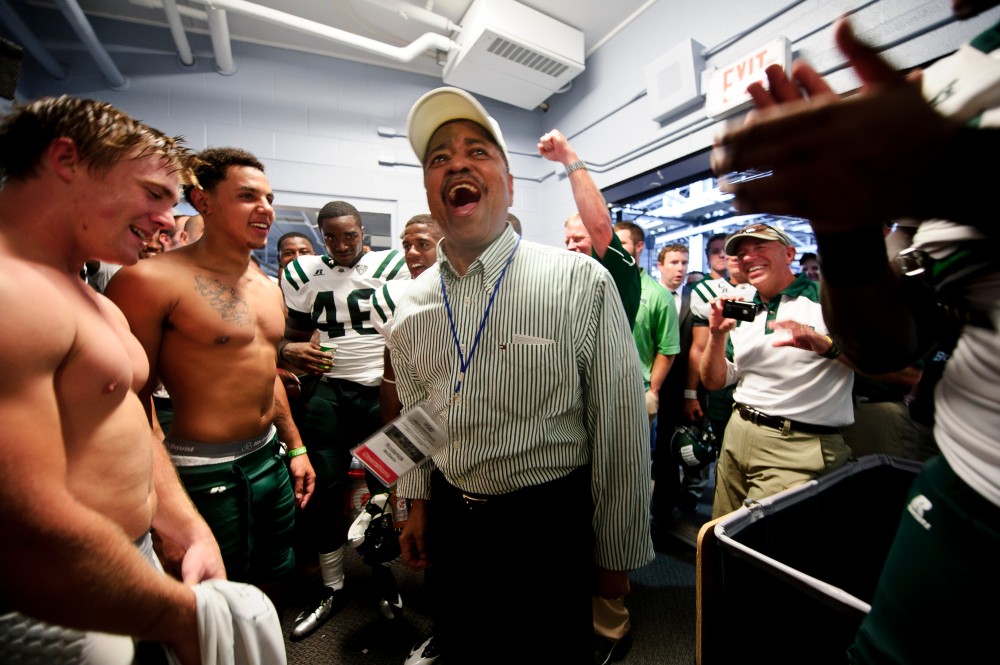
Alex Goodlett
Ohio President Roderick McDavis.
Following the touchdown pass, Ohio capped off the comeback win with an interception of McGloin. The Bobcats clinched the game with a first down, then two plays in victory formation. As Eisenstein put it with his famous final call, “Hello, world. Do you know who Ohio University is now?”
From there, the celebration began. It started on the field, extended to the locker room and returned to Athens.
Thompson: “When you can send (a near-sellout crowd) home upset, there’s not a more powerful feeling in the world.”
Jones: “I would put it in the top 10, but not the quietest (I’ve ever heard Beaver Stadium).”
Tettleton: “I came in (the locker room) late because I was talking to (ESPN reporter) Tom Rinaldi. I had just been on the field for so long soaking it in. It was a surreal moment. Me and coach Solich just had a moment, hugged each other.
“When we walked in the locker room, the place just erupted. Water bottles, everything just being sprayed up in the air. We all kind of got together and started jumping around, music blaring. Things like that last forever.”

Alex Goodlett
Ohio Football Team.
Foster: “It was an experience I’ll never forget. T.J. Carrie deserved the game ball. He had so many things going against him. He was just an all-around leader. For him to be in the (NFL) right now, I understand why.”
Eisenstein: “It’s odd because the stadium is emptying out, everyone’s doing their work in the press box, and I’m in the room by myself. Rob’s down on the field for the postgame radio show. So it’s just me sitting there, reflecting on that moment. It was a really odd, but oddly awesome, moment. It was a lot. It was pretty cool.”
Blankenship: “It was just great to see (then-Ohio University President Roderick) McDavis walking in. Just how proud he was for us and the university.”
Carrie: “The players gave (the game ball) to me just because of what I had went through, surgeries, the battling, being in the instance where I wanted to be out there but I couldn’t, and finding a way to try and coach that team up from my experience. And how I viewed the game to give them the most confidence.
“I was shocked when I got the game ball, actually, because my efforts weren’t able to be displayed on the field. For my teammates to feel that I needed and deserved that, it meant a lot.”
The victory over Penn State is largely considered the greatest in Ohio football history. It served as a catalyst for Ohio’s 7-0 start in 2012, and it became an instant recruiting pitch to prospective Ohio athletes. It was a monumental moment for not just the football team and athletic department, but for the university as a whole.
Solich: “Anytime you beat a Power Five team — especially one that’s got a historic program like they've got — it adds something to it and makes you feel great."
Tettleton: “I would hope that it left a huge impact. I still stay in touch with those guys to this day. If you’re affiliated with Ohio football, people know about the success and the Penn State win. I’m proud to wear an Ohio Bobcat on my shirt.
“I want that place to succeed more than ever. I hope (current Ohio quarterback) Nathan (Rourke) goes out there and breaks every one of my records. The one thing that still kills me to this day is that I never won a MAC Championship. I want them to win it so bad.”
Thompson: “Campus was on fire. No other time had the talk on campus been surrounding the football game on Saturday. What we were able to create, the environment that was created during that stretch, was electric.”
Blankenship: “We knew after that game we could play with anybody. There was no team too big, nothing. It was just so special. Looking back on it, how big it was, it was so significant.”
Dixon: “I think it showed our guys that if you just play the game, not worry about who's on the other side, and execute your assignments and things that you've been coached and the repetitions you got while being coached. It helps recruiting because now guys say, ‘Hey, I can go shine anywhere. I don't have to go to Penn State or Florida or Florida State, Michigan, Ohio State. I don't have to go to those places. I can go and play and still get the opportunity to play against that talent and showcase my ability.’”
Eisenstein: “It was on time. Ohio’s program needed one of those wins. Just from a pure football standpoint, I felt that that was where Ohio announced who they were to the college football world.”
listen
All photos were provided courtesy of Ohio Athletics Archive
Audio was provided courtesy of Ohio IMG Sports Radio Network
Landing Page
This story is part of a series of specially designed stories that represents some of the best journalism The Post has to offer. Check out the rest of the special projects here.